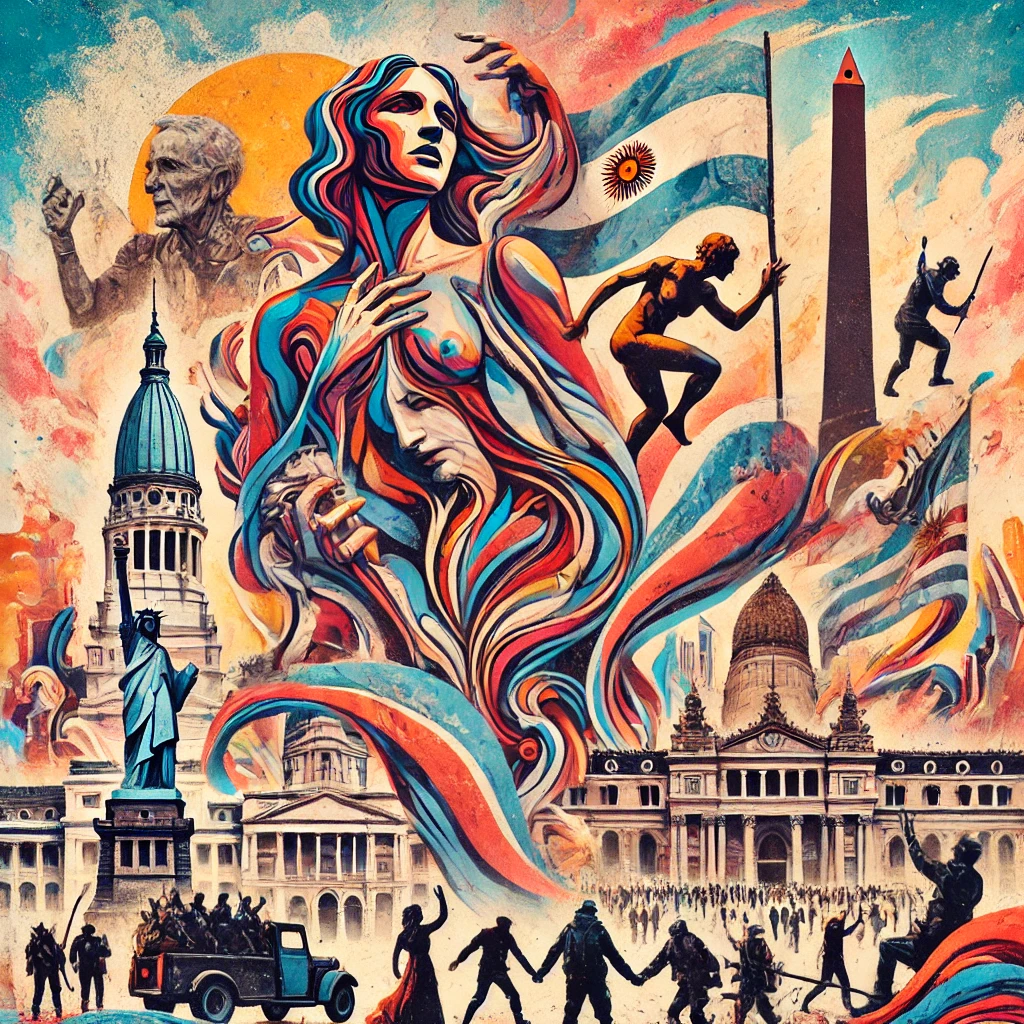Humberto Poidomani, a prominent Argentine artist, uses his diverse body of work to reflect his homeland’s turbulent political and social landscape. Poidomani offers a powerful critique of Argentina’s political history through his paintings, sculptures, and assemblages, exploring themes such as identity, resilience, and social transformation. His art delves into the struggles faced by the Argentine people, resonating with the complexities of the nation’s political saga—marked by military rule, economic crises, and the persistent fight for democracy. Poidomani’s work serves as a visual narrative of Argentina’s history. It acts as a medium through which global audiences can engage with the broader ideological and social issues that continue to shape the country. Visitors to his online gallery can experience these profound expressions, deeply rooted in the Argentine experience of political upheaval and societal change.

Early 20th Century and the Rise of Peronism
In the early 20th century, Argentina was one of the wealthiest countries in the world, thanks to its booming agricultural exports. However, social and economic inequalities were stark, and the political landscape was dominated by a small elite. This began to change in the 1940s with the rise of Juan Domingo Perón, a charismatic military officer who became a significant political figure as the Secretary of Labor and Social Welfare. Perón championed labor rights, social welfare programs, and national industrialization, which won him massive support among the working class and labor unions.
In 1946, Perón was elected president, and his presidency marked the beginning of “Peronism,” a populist movement that combined elements of nationalism, labor rights, and social justice with decisive state intervention in the economy. Perón’s policies were controversial; while they improved conditions for many workers and expanded social services, they also increased state control, political polarization, and economic difficulties.
Military Coups and Authoritarian Rule
The political landscape of Argentina throughout the mid-20th century was volatile and characterized by frequent military coups. In 1955, Perón was ousted by an army coup, beginning a cycle of military and civilian governments. This period was marked by political repression, economic instability, and growing tensions between Peronists and anti-Peronists.
One of the most significant and darkest periods in Argentina’s political history began in 1976 when a military junta overthrew the government of Isabel Perón, Juan Perón’s widow, who had succeeded him after he died in 1974. The military dictatorship that followed, known as the “National Reorganization Process,” ruled until 1983 and was responsible for widespread human rights abuses during what is now known as the “Dirty War.” An estimated 30,000 people were “disappeared” – kidnapped, tortured, and killed – by the regime, primarily targeting perceived political opponents and leftist activists.
Return to Democracy and Economic Turmoil
In 1983, Argentina returned to democracy with the election of Raúl Alfonsín as president. Alfonsín’s administration sought to rebuild democratic institutions and address the atrocities committed by the military regime. Trials of military leaders were conducted, resulting in some convictions. However, subsequent governments would issue pardons as part of national reconciliation efforts.
The late 1980s and 1990s saw Argentina struggle with severe economic problems, including hyperinflation, which led to social unrest and political instability. In 1989, Carlos Menem, a Peronist, was elected president and implemented neoliberal economic reforms, including privatization of state enterprises, deregulation, and opening the economy to foreign investment. While these policies initially stabilized the economy, they also increased inequality and vulnerability to external shocks.
Economic Collapse and Kirchnerism
In 2001, Argentina faced a severe economic collapse, resulting in massive social unrest, bank runs, and a series of short-lived presidents. The crisis was exacerbated by austerity measures and the government’s inability to service its debt, leading to a default. This period’s political and economic turmoil left a lasting impact on Argentine society.
In 2003, Néstor Kirchner, another Peronist, was elected president and sought to move the country away from the neoliberal policies of the past. Kirchner’s government focused on rebuilding the economy through increased state intervention, social spending, and policies to reduce poverty and inequality. His wife, Cristina Fernández de Kirchner, succeeded him in 2007 and continued many of his policies, further strengthening the role of the state in the economy and expanding social welfare programs.
As the policies of Néstor and Cristina Kirchner came to be known, Kirchnerism was characterized by its emphasis on social justice, human rights, and economic redistribution. However, the period was also marked by accusations of corruption, increasing political polarization, and tensions with the media and judiciary.
Recent Developments and Continuing Challenges
In 2015, Mauricio Macri, a center-right politician and former mayor of Buenos Aires, was elected president, marking a shift away from the Kirchnerist policies. Macri’s government attempted to implement market-friendly reforms and reintegrate Argentina into the global economy. However, his administration faced numerous challenges, including high inflation, public debt, and resistance from sectors of the population who had benefited from the Kirchnerist policies.
In 2019, Argentina saw another political shift with the election of Alberto Fernández as president and Cristina Fernández de Kirchner as vice president. This return to a more Kirchnerist approach reflected the ongoing debate in Argentina over the best path forward for economic development, social justice, and democracy.
The Ongoing Political Landscape
Argentina grapples with significant political and economic challenges, including inflation, public debt, poverty, and political polarization. The country’s history of military coups, authoritarian rule, financial crises, and populist politics has left a complex legacy that continues to shape its political landscape. Issues such as economic inequality, corruption, and human rights remain central to political discourse, and the country’s future depends on its ability to address these challenges while maintaining democratic governance and social cohesion.
Argentina’s political saga is a story of resilience, struggle, and the quest for a more equitable and democratic society.
